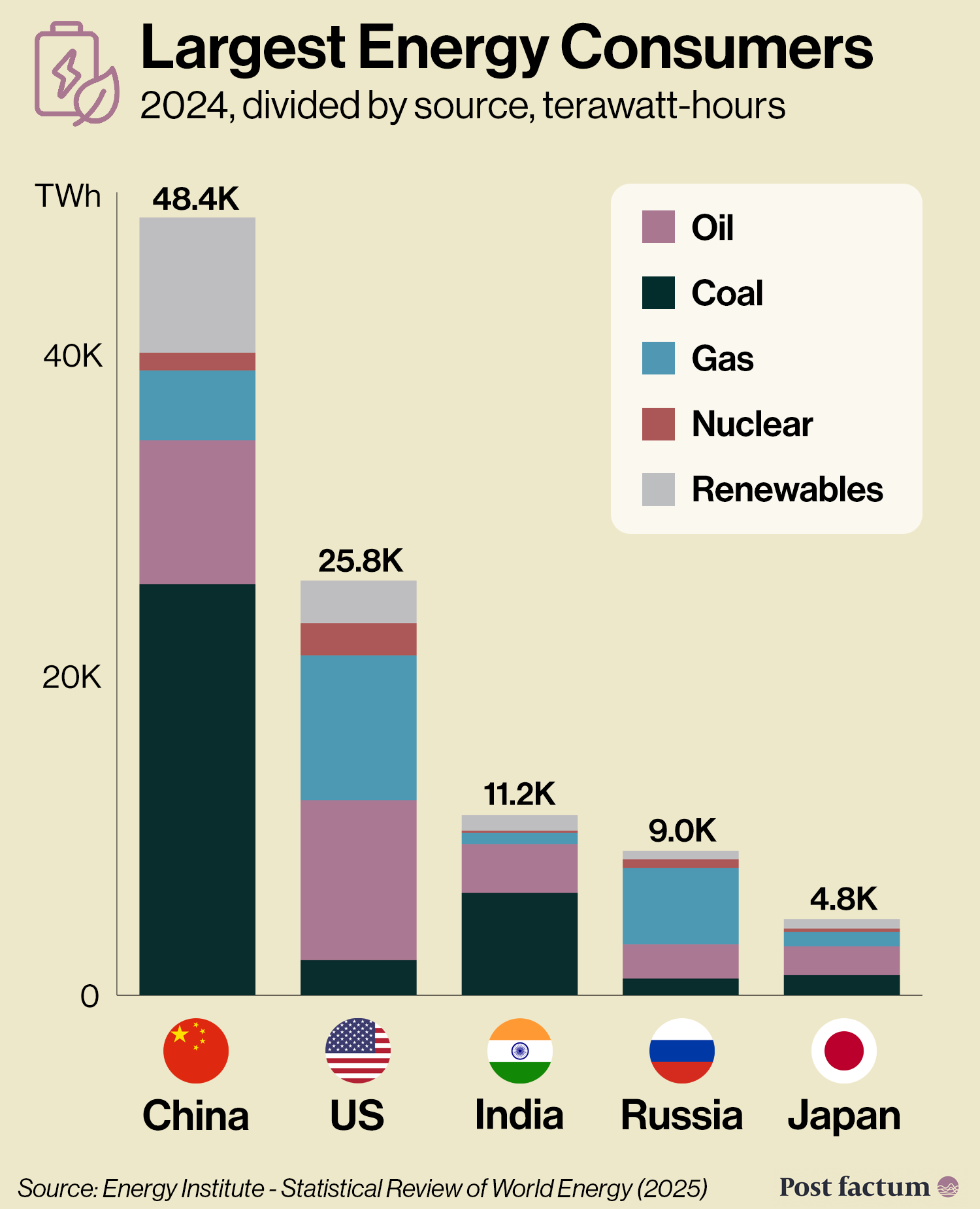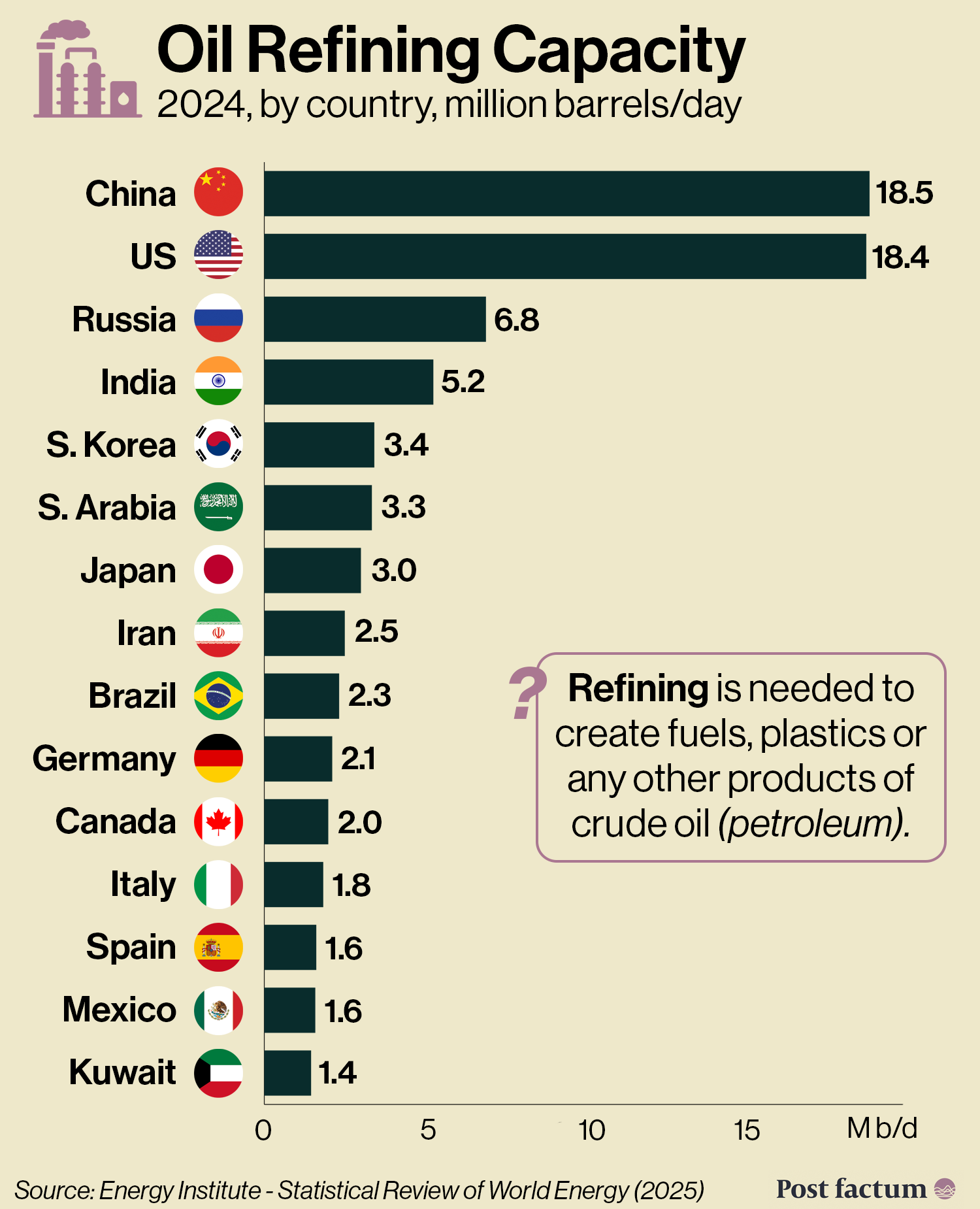Geopolitics of Crude Oil
7 Terms to Understand the Oil Market
Remastered: November 24, 2025
30% of all energy used by humans comes from oil.
Fuels for cars, planes and ships are made from crude oil (petroleum).
Electricity is sometimes generated from burning oil products, and often from burning natural gas, 20% of which is extracted together with oil.
Oil is also used to make plastics, fertilisers, cleaning products and more.
As a result, any economy needs oil to work and grow.
Shipping and transportation is a part of most economic processes.
Cargo ships, airplanes and heavy trucks mostly use fuel made from crude oil, like diesel and kerosene.
Oil is a component of almost any product or service.
Because of this, oil is a component of almost any product or service.
Changes in the price of oil affect prices in the economy in general.
An increase in oil price increases the costs of production, pushing up prices for most goods.
A decrease in oil price does not lower prices in general, as producers increase profit margins instead.
In the US, a political party has better chances of re-election when fuel prices and inflation are low.
Buyers of oil try to defend from price shocks:
Factories and industries buy futures contracts (promises to buy later at a pre-agreed price), allowing them to know their costs in advance.
Governments are also worried about having enough oil and other energy sources.
What moves the price of oil?
Oil price is mostly created by demand and supply.
Prices rise if global demand for oil is higher, or less of oil is supplied.
Prices fall if the world uses less oil, or more of it is produced.
This basic economic law is especially true for commodities like oil, gas, coal, grains or metals.
There are different types of oil, mostly based on its “sweetness” (sulphur content), density or acidity.
Malaysia extracts highest quality crude oil, while Brent and WTI types produced in the US are of higher quality than the oil from the Middle East.
Oil needs to be shipped (transported), normally by sea tankers or through a pipeline.
Limits to capacity to transport oil or disruptions to trade routes affect price.
Economic growth creates demand for oil and increases its price.
The efforts to make the global economy less dependent on oil, like using nuclear and renewable energy, are slowly breaking down this link.
Get exclusive content.
Become a Founding Member today.
Where does the supply of oil come from?
The supply depends on oil reserves available for extraction at a reasonable cost.
Largest producers of crude oil are the United States, Saudi Arabia and Russia.
Historically, they have always been the 3 major suppliers of oil.
Can oil reserves run out? Currently known reserves are expected to be gone in 47 years, but new ones become available as extraction technology improves and becomes cheaper.
Where does the demand for oil come from?
Because oil products are related to economic activity in general, the demand for oil correlates with the size of the country’s economy.
The largest importers of oil are China, the US, the EU, India, South Korea and Japan.
Changes in economic performance of these major buyers have an impact on oil prices.
For example, oil prices grew as China experienced faster-than-expected economic recovery from the pandemic.
Suppliers can slow down the production of oil or invest in its expansion to control prices.
Oil-producing countries use this power to project influence globally.
OPEC (Organisation of the Petroleum Exporting Countries) is a partnership of oil suppliers.
Goal: to coordinate how much oil is produced, controlling prices (in economics, this is called a cartel).
OPEC is led by Saudi Arabia and has 12 member-states.
A number of other major producers (known as OPEC+) have supported its strategy in most cases.
OPEC has launched a number of “price wars”:
2014-16: Saudi Arabia and OPEC increased production, causing a fall in price. Goal: trying to stop the growth of US oil and gas industry, which needed higher prices to be profitable. This price war eventually failed.
2020: Saudi Arabia launched a price war against Russia when it refused to join in on OPEC+ production cuts. This was successful at making Russia agree to the cuts.
OPEC accounts for around 35% of global oil production, while OPEC+ combined has around 60%.
Market sentiment
Oil is a traded commodity: many traders buy contracts for oil delivery only to sell them, not to receive the oil themselves.
Because of this, market opinion on where the price will go is quickly reflected in the real price.
For example, if China reports strong economic statistics, the price of oil is likely to increase as investors expect higher demand than before.
7 Terms to Understand Oil Geopolitics
Refining
Crude oil must be refined before it can be used as fuel or material for plastics, synthetics and other products.
Refining is a complex industrial process that needs expensive infrastructure.
Many oil-producing countries do not refine their oil and instead export it raw, then importing the products made from it.
True self-sufficiency in oil requires enough of both production and refining capacity.
China (which consumes lots of oil without producing much) has a vast refining capacity.
Refining helps China counteract its dependency on exporters of oil with their own demand for refined oil products.
Shale energy
Shale is a type of layered rock that often holds crude oil and natural gas.
innovations in drilling allowed to increase the efficiency and output of shale oil and shale gas industries.
The United States expanded these sectors significantly since 2008. They now account for about 50% of the country's oil and gas production.
This growth allowed the US to become the largest producer of oil.
Shale oil is more expensive to produce than other types and requires higher market prices of oil to be profitable.
Saudi price war of 2014-16 was targeting the US shale industry by lowering global prices, but it survived.
An advantage of shale extraction is that it can be paused and restarted at any time, unlike regular oil extraction.
Cost of production
Depending on the location and the type of the oil, technological and industrial specifics, some countries can produce oil much cheaper.
In Saudi Arabia production costs are around $5-10 per barrel. In Russia’s — $15-20.
The US the costs range from $30-70 per barrel, with shale oil being more expensive.
At any given price some oil producers can profit and others can struggle.
Break-even price
Break-even is a specific price at which the earnings from oil sales will cover the country’s overall budget deficit.
Some countries rely on oil exports for a large part of their revenue and need to sell their oil at a certain price to get enough.
For example, Saudi Arabia enjoys a low cost of producing oil ($10), but they must sell it at a higher price ($90) to not have a budget deficit.
Currency reserves
Currency reserves is the foreign currency (especially the US dollar) held by a country.
Having enough foreign currency is needed to buy imported goods.
If the local currency becomes too cheap, its price (exchange rate) can be boosted by spending foreign currency reserves on buying the local currency.
Saudi Arabia used its currency reserves to balance its budget while waging price wars.
Hedging profits
Hedging is a strategy when one investment is balanced with its opposite, so that you do not lose as much in case the original position fails.
In the case of crude oil: when producers enjoy high oil prices, they can hedge their risk by betting on oil prices to fall, expecting to gain profit whichever way prices go.
This is important for planning long-term investment into expanding production, as having hedged future profits provides security.
Self-sufficiency
In an ideal world, countries would buy their oil at the cheapest prices from the best producer.
In reality, when the producer gains too much power over the buyers, it can use this dependency to increase prices and punish the buyers.
Because of this, countries want to achieve self-sufficiency in oil: independence from imports.
For example, the US increased its production by expanding shale oil, meaning they can cover their own demand. High refining capacity also helps this.
In contrast, European countries produced energy from imported oil and gas, especially from Russia.
Cutting off trade with Russia after its invasion of Ukraine increased the prices of energy and required finding new suppliers, costing the EU over $300bn in energy subsidies alone.
You can read more about the Global Energy Crisis (2021-23) in our separate report.
Author Anton Kutuzov
More below:
Join the discussion:
Thank you for reading!
Become a Founding Member to receive our exclusive second weekly newsletter, support our independence and get perks!
NEWS BREAKDOWN
Biggest events of the past year, analysed





